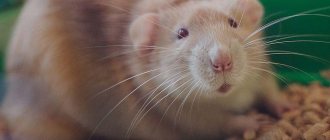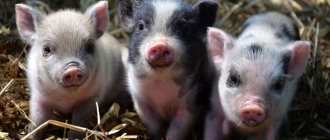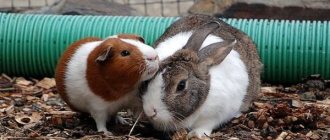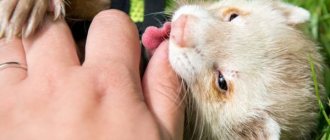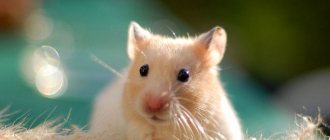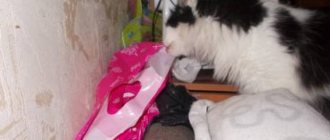Let's talk about shedding. Moreover, this question is relevant for absolutely every owner of a dwarf rabbit.
In addition, given the number of calls to my mobile phone, I can conclude that molting scares almost all future and current owners of dwarf and decorative rabbits .
A rabbit usually sheds several times a year, starting at the age of 3.5-4 months. But depending on the intensity of molting, it varies.
And one of them is molting
By the way, wild rabbits, as a rule, can shed twice during the year, while domestic rabbits – more often. There are rabbits that can successfully molt for a whole year, and this happens to those rabbits that live in houses with central heating (year-round molting).
As a rule, a rabbit loses its hair 2-3 times a year, and if everything is in order with the rabbit’s health, then new hair will grow very quickly in the place where the hair fell out.
Like any animal that has fur, rabbits shed.
In some cases, the rabbit's fur will fall out in clumps, and your pet's body may even develop completely bald patches.
But if within a few days the hair grows back in the place where the bald spots formed, then, as a rule, there is no need to worry.
And yet, if rabbits lose hair, what should you do?
If this is due to shedding, then the actions here are as follows: if the rabbit sheds, then it must be combed, preferably every day. This will help reduce the amount of hair that ends up in the stomach. I would like to add that if a rabbit sheds, then it begins to wash itself especially actively. At the same time, he swallows the so-called “dead wool”.
It is necessary to ensure that your pet has free access to hay, as this is a very important food, and it is what helps the fur that the rabbit swallows pass out.
Rabbit feces pellets stuck to fur
Carefully monitor your intestinal function - if the size of the fecal pellets has decreased, or they have become dry and sticky, pay special attention to this. If you nevertheless notice that the size of the fecal balls has decreased or they have stuck to the fur, but the rabbit behaves as usual, then you can give your little ear (5-10 ml) Vaseline oil. It is available at the pharmacy. But be careful, if along with a change in the structure, size or complete absence of fecal pellets, you see either a depressed state or a change in behavior, then it is likely that your rabbit has slow bowel function. And this problem will require urgent treatment by an experienced doctor.
However, there is also abnormal hair loss, which can be caused by the following types of diseases.
Preventive actions
The basis for preventing the occurrence of pathological molting in rabbits is vaccination. This is especially true for lichen, which most often affects eared animals. Veterinarians use 2 drugs for this:
- Vakderm vaccination – prevents the development of dermatophytosis;
- Microderm vaccine - the purpose is identical, but differs in a live lyophilized form.
There are Vakderm TM and F products, but their use in rabbit breeding is prohibited.
To prevent the animal from forming a fur ball when shedding, experts recommend using the following preventive measures:
- starting from 4 months of age, introduce 1 prune into the diet 4 times a month;
- from the very beginning of shedding, give 3 ml of petroleum jelly every day, once a day;
- Buy a special paste for hair removal at the veterinary pharmacy, for example, Gimpet malt-soft, Gimbi Nager-Malt Paste, etc.
Do not forget about the conditions of detention, the purity of water and the quality of food, which determine the degree of infection by bacteria, viruses and fungi.
Shedding in rabbits occurs for physiological and pathological reasons; it is difficult to get rid of it, since natural processes take time and the cause of the disease must be eliminated. If you strictly follow all the recommendations, you will make life much easier for your pets during their coat renewal.
0
0
Copy link
And the first thing is ticks
Mites in rabbits, or ectoparasites as they are commonly called, can live on the animal’s skin , in the hair follicles of the coat, or in different layers of the skin itself .
Life stages of the fur mite (Cheyletiosis)
A rabbit can be affected by several types of mites. fur mites (cheiletiosis) are responsible for hair loss in rabbits . This type of mite does not penetrate deep into the skin of the animal, prefers to live on the surface and feeds on dead skin cells.
Cheyletii lays eggs at the base of hair growth points. Subsequently, the resulting larvae use blood and the secretions of the sweat and sebaceous glands for food. This causes the rabbit's hair to thin out and fall out on its neck and back.
With cheyletiosis, if you are armed with a magnifying glass, then, as a rule, in the area of the neck and torso, you can see an unusual visual effect - “crawling” or “walking” dandruff. This effect is caused by fur mites moving under the skin scales. You may also notice skin inflammation and a rash at the affected areas.
The scabies mite (Sarcoptic mange), also known as a subcutaneous mite, bites into the skin, making passages in it, where it lays eggs
Scabies mite (itching scabies) or sarcoptic mange also known as subcutaneous mite – I have encountered this type of mite first-hand.
As a result of its vital activity, tubercles appear on the animal’s skin, in the form of wounds and crusts. If the disease is not treated, then the focus of infection grows, abscesses form at the site of the wounds, the rabbit's hair falls out in clumps around the wound, the next stage is fistula.
In addition, the tick constantly gnaws passages and tunnels in the animal’s skin, laying eggs in them, which causes severe, persistent itching. Trying to get rid of it, the fluffy most often introduces an infection. Ulcers form under the rabbit's skin. The animal loses weight, which can lead to exhaustion and death.
How I got rid of subcutaneous mites
On March 18, 2014, a subcutaneous mite was discovered in a rabbit. An injection of Invertin-10 was given, dosage 0.1 ml.
As I said above, subcutaneous mites were discovered in rabbits on my farm and the well-known ivermectin helped me in treatment.
And although there is a claim that this drug is toxic and has some side effects, which prompts you to be careful about its dosage, it works 100 percent.
As for the dosage itself
03/22/2014, the fourth day after the injection, there are no signs of ticks, the wounds are healing.
I used the drug Ivermectin-10. As for the dosage for rabbits, it was not included in the instructions for use, since the concentration of ivermectin - 10 milligrams of the substance per 1 milliliter of solution (1% solution) is convenient for injection into larger animals.
I had to do, in general, not complex calculations. On average, it turned out to be 0.1 ml of Ivermectin-10 per rabbit weighing 3 - 4 kilograms.
03/31/2014, after another 9 days, the wounds had almost healed. New fur is growing
Although the injection was done once, and also to increase the volume of the injection itself, I added 0.1 ml of Ivermectin-10 to the 0.9 ml of water for injection already drawn into the syringe, which, as they later explained to me, was not professional from a medical point of view, nevertheless, the result exceeded all expectations.
We can see in the photo nearby how the rabbit’s fur falls out in clumps around the wound it has formed.
There we will be able to see how the rabbit, over time, got rid of his illness.
To be honest, I subsequently increased the dose of Invertin-10 from 0.1 ml to 0.2 ml per adult rabbit. The effect was visible already on the second day. No side effects were observed.
And further:
For cat lovers
At my house there lives a beautiful, intelligent, ash-colored cat, a family favorite named Sirko.
A cat named Sirko
It was not possible to remove ticks from him using Ivermectin-10, although I followed the recommended dosage for dogs and cats, 0.2 ml per 10 kg of animal weight. And these animals are much more sensitive to increased dosage than rabbits. I had to use more expensive drugs.
Ear mite or rabbit psoroptosis
Signs of ear mites in a rabbit
Ear mites or Psoroptosis most often live inside the rabbit's ear, so the disease itself, rabbit psoroptosis, is also called ear scabies . Few rabbit breeders are not familiar with this disease, but rarely does anyone allow ear mites to cause hair loss in their pets.
But still, unfortunately, this is possible.
Rabbit after treatment of severe psoroptosis
So, it is quite easy to determine psoroptosis in rabbits. If the inside of your fluffy’s ears are clean and he doesn’t rub them with his paws in vain, then it means he’s healthy, but if you notice that your pet often scratches his ears, and strange brown crusts have appeared inside his ears, then this is it, you have there is an ear mite visiting; due to inexperience, the consequences of its activity can be mistaken for ear rotting.
And if it is not removed, then over time it will fill all the ears, move to the head and neck, and then to the back. In the photo above you see a rabbit that was cured of a severe advanced form of psoroptosis, but how much money and effort will be needed to restore this animal.
It is also worth noting, as mentioned above, the disease occurs in several stages and has different degrees of severity. With the aggressive development of the process, a violation of the integrity of the eardrum may occur, followed by inflammation of the middle ear, meningitis, damage to the central nervous system - the rabbit may spin and fall, after which the death of the animal occurs.
Well, we found ear mites in rabbits, all that remains is to find an effective treatment, and at home.
Amitrazine-plus
Amitrazine Plus has always helped me in the treatment and prevention of psoroptosis in rabbits.
The crusts inside the rabbit's ear are generously lubricated with a preparation that has an oily base. Once soaked, they are removed from the ear cavity relatively easily and almost painlessly for the rabbit.
The drug itself penetrates well into deep areas of the skin and effectively destroys mites. During treatment, a bottle of amitrazine plus (10 milliliters) was enough for me for about 4 - 5 rabbits. After 3 – 5 days I repeated the procedure.
Later, for prevention, as well as during treatment, during the repeated procedure, I began to use aerosol antiparasitic agents. As one rabbit breeder said, “zilch” twice and forgot for a long time.
And of course, you always need to remember that it is cheaper to plan and carry out preventive measures to combat ticks, or to restore the health of your animals. And in conclusion of this topic, before we find out what else can cause hair loss in rabbits, let’s watch the video provided to us for review, in which veterinarian Maxim Nikonov will tell you how else you can get rid of ear mites in rabbits.
Genetic features
Hair loss in rabbits can be caused by genetic changes. There is no way to get rid of this problem. The breeding value of such individuals tends to zero. In decorative rabbits, genetics are characterized by the greatest confusion, because breeders, when crossing breeds, pay more attention to the aesthetics of appearance. This does not always contribute to maintaining health. Bald individuals appeared after crossing animals with a modified coat type, in particular rex rabbits.
Decorative rabbits go bald as part of two types of changes:
- Semi-lethal, which is caused by failures in the absorption of proteins and their processing. In this case, pets are unlikely to survive up to 1 month.
- Natural. Such animals actually do not have any disturbances in physiological development, but they have almost completely no hair. At the same time, fur may appear after 3 months of age.
It is impossible to get rid of the congenital lack of fur or increase fur growth. Such individuals will not participate in the breeding process, since failures in the genotype will be passed on to the offspring. Manifestations of violations may not appear in the first generation, but will certainly arise in the subsequent one.
Fleas on rabbits
Insects such as fleas are very rare in rabbits. But your pets can become infected either from dogs or cats that roam freely around the yard.
As a result of prolonged infection, an allergy to flea bites may occur. The result is that the rabbit’s fur begins to fly out and fall out.
Fleas are also dangerous for rabbits because they carry a disease such as myxomatosis. Therefore, do not forget to get all your eared dog's vaccinations on time and check it for fleas.
When treating, flea products are often used for small kittens . Basically these are drops that are used on the withers of the animal.
But if you have a decorative rabbit, be careful with the drops. Even for kittens, the drops can be highly toxic for your pet. For them, veterinary medicine uses a special spray that is applied along the spine.
At what age does adult fur appear?
During the molting period, the soft fur changes to a coarser one, which is an indicator of maturation. It is common for decorative rabbits to change their fur twice. This happens at a fairly young age. The first age molting occurs 1-1.5 months after birth. After two weeks, the second occurs, at about 4 months of life.
Reference! With a high-protein diet, the timing may shift, and age-related molting is completely completed after 65 days.
Known as lichen, “ringworm” or microsporia
Sometimes hair loss in a rabbit is due to a condition called microsporia or " ringworm ".
As a result of the activity of this microorganism, clearly defined bald spots form on the rabbit's fur. You may notice small red spots and slightly noticeable irritation on the body.
This disease is recommended to be treated with drugs such as miconazole, as well as ketoconazole.
But still, if you find lichen in rabbits on your farm, first consult a qualified veterinarian about treatment.
It is also not recommended to use drugs and ointments intended for humans during treatment, since they are not designed to get inside the animal.
Consequences of urinary dermatitis.
When the cages are contaminated, rabbits rub against structural elements and are affected by aggressive chemical substances that are formed during the decomposition of urine and feces or their direct impact (sticking after defecation). Here, the paws and back of the body, genital areas are most often affected, but manifestations behind the ears are not excluded. You may ask, how can this be, since rabbits are extremely clean?
| Subscribe to our website's weekly newsletters: ✦ BROTHER RABBIT ✦ Current notes on keeping rabbits are waiting for you. SUBSCRIBE |
That’s how it is, but there are force majeure circumstances. For example, bladder problems (urinary incontinence), gastrointestinal disorders (diarrhea) or coccidiosis, poor motor skills or complete paralysis of the limbs, general loss of activity due to some illness. Inspect such an animal more often, wash away dirt with baby soap. To relieve inflammation, use Aloe Vera gel and fight flies that can lay larvae at the affected areas. If the measures taken are ineffective, you notice depression in your pet and even an increase in temperature, contact the clinic to prescribe an antibiotic.
Eating fur from other rabbits
In this case, in order to understand that this is the main reason for hair loss, you need, as they say, to simply “catch the rabbits red-handed.” In general, this whole process of overeating is not typical for rabbits, and may mean that your pets are bored. Give your rabbits more time to walk, look for some new toys for them. This will help them take their minds off each other's fur
There is also such a thing as self-eating . If your pets are stressed or in pain, they may begin to eat themselves. Be sure to find out the reason for this behavior and eliminate it.
Other reasons
If your rabbit is going bald, but no disease has been detected, there may be other factors causing the hair loss. Sometimes eared animals lose their fur after using medications - if an allergy to the drug has appeared or the drug was administered incorrectly. In addition, shreds of fur can be torn out by relatives in a fight; in some cases, rabbits are capable of chewing off their own fur.
Eating fur from other rabbits
Experienced farmers have repeatedly noted that sometimes pets enthusiastically gnaw the fur of their cage neighbor. The strange behavior of rabbits tearing out shreds of fur from their relatives can be caused by the following reasons:
- Overpopulation of cells. Animals kept in close quarters begin to experience discomfort and become very nervous, gnawing on their own or their neighbor’s fur.
- Aggressiveness. During the period of sexual heat, males often bite female rabbits on the sides and scruff of the neck, tearing out the hair.
- Boredom . No matter how strange it may sound, rabbits, like people, can also get bored. If there is little free space in the cage for movement, and there is no object on which to sharpen their teeth, pets switch to the neighbor’s fur. This problem is more relevant for decorative breeds.
The rabbit chews its own fur
If the animal pulls out its fur on its own, and there are no external symptoms or signs of disease, then this can only mean one thing: the animal is experiencing severe pain and stress, which is why it begins to literally torture itself, tearing out shreds of fur. If you notice this behavior, you should immediately contact a veterinarian for examination.
Hormonal imbalance
Despite the fact that this disease is extremely rare, it can still be one of the reasons for hair loss in your pet and the answer to the question that has been bothering you for so long: why do rabbits lose hair? And if the vet makes just such a diagnosis, then in all likelihood he will take a blood test from the rabbit. This is done in order to send a test to a laboratory and study the function of steroids to identify other symptoms of hormonal imbalance.
All of the above is precisely the answer to many questions about rabbit fur.
In the next article we will answer this question: should you give your rabbit carrots? Read our new articles and see you!
Incorrect content
Failure to comply with the requirements for keeping rabbits can cause deviations that cause baldness.
Hormonal imbalances
With such a rare disorder, growth retardation, lack of offspring, and deviations in the formation of the skeletal structure and coat are possible. Problems can be caused by:
- Long-term deficiency of vitamins K and E, selenium. Against the background of vitamin deficiency, deviations occur in the process of synthesis of pituitary and adrenal hormones.
- The use of hormonal agents and supplements. When there is an excessive amount of estrogens, for example, dairy products, soy, the production of hormones in organisms is disrupted, which provokes changes in the coat.
Urinary dermatitis
Contact of the body with a dirty floor, on which a large amount of dried waste accumulates, provokes irritation of the skin with salts. If they contact for too long and often, then even burns are likely, followed by hair loss. Such lesions can be found in the rump, belly, and groin areas. For prevention, you should regularly clean the floor in the cage or enclosure.
Are you here
Questions can only be asked after registration. Please login or register.
Good day everyone, I have a problem with a breeding male of the Risen breed, I noticed that his fur began to fall out, but most importantly, there is some kind of dandruff that is also profuse, what do you recommend, I looked through the forum about this topic and didn’t find anything specific, I want it today give an injection of Ivermec, as you think is correct
Right. Also, on the second or third day after the injection, thoroughly scorch the cell with fire. Disinfect under the cages as well.
There is a search on the forum. Actually, Maklyak once posted a link.
You never get a second chance to make a first impression.
There is a search on the forum. Actually, Maklyak once posted a link.
Thank you Alexander, I think I figured it out yesterday, Olga also gave me a huge hint, this morning I gave an injection of Ivermek 0.2 mg, the blind man said “we’ll see”
But the question immediately arises, I just couldn’t find it anywhere, should a repeat injection be done and when?
And in general the rabbit got sick for some reason, but again it’s a pity, it looks like he’s a 2-year-old manufacturer, weighs 9600g, and doesn’t look bad on his face, everyone else is normal, even those who are in the same room with him, maybe you shouldn’t be sorry
But the question immediately arises, I just couldn’t find it anywhere, should a repeat injection be done and when?
After 7 days, repeat the injection.
You never get a second chance to make a first impression.
OK,
Better in 10-14 days. This is due to the developmental cycle of the suspected mites. We write - diet, maintenance, sexual activity. Rabbits go bald both from a lack of fiber and from disturbances in the intestines, which can be due to a lack of fiber, and from a lack of B vitamins, especially B12 (yeast, B12 injections, internal B vitamins), and from a lack of fats (flaxseed the seed works well, you can use fish oil and cake), they can simply wipe it off and get dermatitis. It could be a fungus - we take it and inject it with Microderm - a cool thing. Wow.
Being a veterinarian is a way of life. You can throw dirt at a person, but the dirt may not reach you, but the dirt will remain on your hands. (O. Khayyam)
Symptoms
Signs of the disease:
- Redness of the eyes.
- Formation of a tumor or swelling.
- Purulent or mucous discharge.
- Hair loss around the eyes.
- Increased lacrimation.
- Allergic reactions.
External examination may reveal additional symptoms, including swelling of the iris with white or pink nodules. The accumulation of fluid in the cornea and constriction of the pupils when examined by a specialist indicate the development of the disease.
Increased sensitivity of the eyes to light occurs when the lacrimal sac is inflamed. Painful sensitivity to light is associated with an abundant accumulation of microbes. Bacteria quickly settle on weakened areas, actively multiplying and irritating the connective mucous membrane.
Treatment of rabbit conjunctivitis
A veterinarian can accurately diagnose and eliminate the root cause of the disease. Before visiting a specialist, the rabbit should independently wash the numb and stuck together areas with a weak solution of potassium permanganate (potassium permanganate). The rinsing solution should be pale pink in color.
Acute form
The acute or catarrhal form at the initial stage is easier to treat.
The development of the disease occurs quickly with its main symptoms and manifestations. Primary signs of inflammation must be eliminated by washing the eyes. You need to wash the affected areas yourself with antiseptic drugs. The resulting dried crusts are soaked and then cleaned:
- Albucid solution 3%;
- a weak solution of potassium permanganate (2 crystals per glass of water);
- furatsilin (ready solution or dissolved tablet in 12 glasses of water).
In the acute form of the disease, the veterinarian prescribes eye treatment with the application of anti-inflammatory ointments or drops to the eyelid area.
Primary signs of the development of the disease should alert breeders. The disease can become purulent.
Purulent form
Infection with this form of damage to the eye mucosa spreads rapidly. The purulent form is characterized by severe swelling of the conjunctiva and copious discharge. The discharge dries and forms a brown crust, sticking the eyelids together. Wet fur begins to fall out, painful erosions and ulcers form on the cheeks.
Self-treatment consists of washing with the same solutions as for catarrhal form: instillation of antibacterial eye drops, treatment with antimicrobial or antiviral drugs. Irritated areas of skin under the eyelids are wiped and treated with iodoform or boron ointment. Tetracycline, hydrocortisone eye ointment is placed under the animal's eyelid.
The veterinarian prescribes treatment for purulent inflammation of the conjunctiva with antibacterial and antiviral drugs. The drugs suppress the activity of pathogenic microflora, reducing irritation. Corticosteroid drugs are placed under the eyelid. Treatment and treatment of purulent areas is best carried out by a specialist until the animal has fully recovered.
Inflammation of the mucous membrane in any degree of damage can be cured. Untimely treatment can become chronic with more complex consequences including loss of vision.
